Beneteau First 53 on test: A racy cruising boat with superyacht characteristics
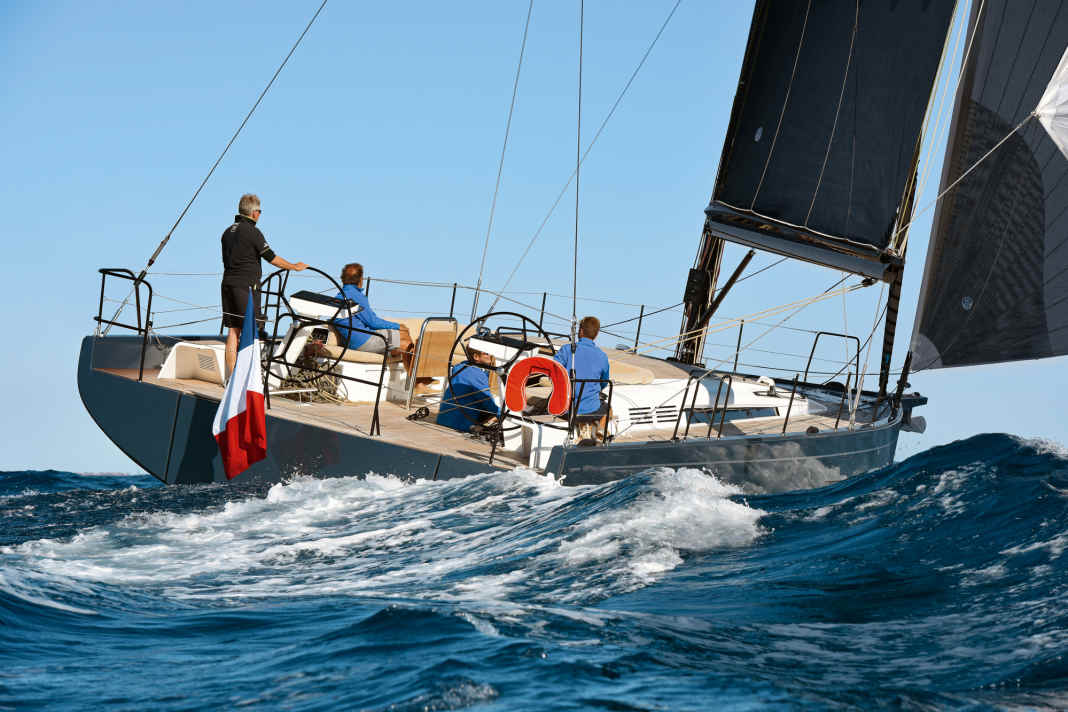





Some sailors are unfamiliar with the range of modern yachts on offer. They have become too confusing, too bulky, not elegant enough and not independent enough. That's true. But then you see the Beneteau First 53, a boat with which Beneteau wants to reinvent the performance cruiser and, to a certain extent, itself, developed over a period of more than three years, far longer than usual, and which challenges conventional wisdom from afar. No, this is no zeitgeist monotony!
The vertical stern looks almost dainty, despite or because of its enormous width of five metres. It seems to float above the water. Even the twin rudders protrude two handbreadths. And something else adds to the impression of lightness and elegance: the deck and cockpit are on one level and remain completely open aft - all the way to the outside of the hull shell.
Even the benches for the helmsman are visually slender: hollow and curved, they protrude above the teak deck, as if floating.
It's an image that seems almost disturbing - certainly enough to make passers-by pause for thought as they stroll along the jetty of Port Ginesta at the end of October, the marina south of Barcelona where Beneteau has had its own base for three years and where we were able to test the First 53 extensively for the first time as part of the selection for European Yacht of the Year.
There is a good reason for the sensation caused by the yacht from France: visually, there is hardly anything comparable, at least not of a similar size or origin. In its minimalism and elegance, the new First is far more reminiscent of a Wally. Which - as will be shown - is anything but a coincidence.
More super yacht than series yacht
The flat superstructure, which can also be covered in teak on request, stretches out in front of the distinctively designed cockpit, which tapers towards the guest area. Everything is streamlined and aligned. It's hard to imagine putting a sprayhood on here; protection from spray and rain is of course available as an extra, and the slightly slanted forward companionway bulkhead almost demands it, because it only remains tight when both the hatch and bulkhead are closed. But even when folded away, a sprayhood would undoubtedly spoil the appearance of this carefully designed yacht.
Running decks up to 80 centimetres wide lead onto the completely unobstructed foredeck, another luxury that has become rare on yachts from large series in these times of interior space maximisation. They are only slightly higher than the cockpit floor, which is why a small step at the height of the steering positions equalises the level.
This also fulfils a second purpose: On the starboard side, it conceals the shore power connection, and on the port side, the filler opening for the diesel tank. The shipyard has gone so far to achieve the impression of sheer tidiness that it has developed two moulded parts for the covers. The main thing is that nothing distracts the eye from the shape and proportions.
Even the electric winch on the foredeck, which is fitted as an extra for hauling mooring lines or mooring ropes, is retractable. The optional Nomen cleats are hinged and all hatches are flush with the teak deck. And as if that wasn't enough, the forward-flattening bulwark conceals the necessary deck step - a lesson in harmony.
The effort Beneteau has put into this is unusually high. It stands in striking contrast to the sales figures recorded by the previous, sixth generation of the First series. They fell far short of expectations - and behind the almost legendary success of the First 40.7, for example, which was one of the best-selling models in the shipyard's entire programme at the turn of the millennium.
For a long time, it was unclear whether there would even be a continuation of the First series. Ten years ago, the brand name, which is inextricably linked to Beneteau's rise to become the world market leader, went completely unmentioned for the first time at the annual press conference held as part of the Cannes Yachting Festival. One might have thought that the range of sporty boats, which had already been reduced by several models, would soon be phased out completely. "Is Beneteau stopping the First model series?" asked YACHT online at the time.
There was reason to doubt. The performance cruiser genre had already come under pressure worldwide. Bavaria was the first to react and discontinue the less successful Match series. X-Yachts began to shift significant parts of its business to the successful XC cruising boat series. Dufour cancelled the performance models. Dehler stumbled several times before Hanseyachts provided new momentum by taking over the brand and relocating production to Greifswald.
In this climate of caution, even scepticism, which was exacerbated by the 2008 financial crisis, Beneteau's withdrawal from its core business would not have surprised anyone. But Annette Roux, granddaughter of company founder Henri Beneteau and still the grey eminence of the industry leader, decided otherwise. Known for her anti-cyclical strategy, the shareholder decided back in 2015 that the First line should not be allowed to die.
Expertise team
In Gianguido Girotti, she brought a professional on board who seemed to be perfect for this and other tasks. The Italian studied boatbuilding in Southampton and then worked for several years as a designer in Germán Frers' team. He then moved to Grand Soleil, a brand that is now one of the direct competitors of the new First series.
Girotti was promoted twice during their development: first to Director of Beneteau's entire product range, then this summer to Co-CEO of the shipyard group. It just so happened that Damien Jacob, his right-hand man, is also a designer with first-class industry expertise. Jacob previously worked in the development department of X-Yachts, another competitor for the French company's new ambitions.
The early phase of the project shows just how big these are. Gianguido Girotti organised a competition under the seal of utmost secrecy among renowned designers who were to present their initial designs and studies. There was no fee, only the prospect of one of the most exciting tasks in series boat construction in the coming years. Little was revealed about the competition and the participants. According to YACHT, almost all the leading offices were represented.
The contract was awarded to Lorenzo Argento and Roberto Biscontini, two of the most established representatives of their trade. Argento has already designed for Brenta and Wally, which explains the close relationship between the Beneteau First 53 and the icons of the superyacht scene. He is as much a stylist as a designer, an aesthete as an engineer and previously worked for Michael Schmidt Yachtbau. Since his debut for Beneteau, he has also shaped all other new developments in the First series, including the First 36 and First 44, as well as the cruising version derived from the First 53, the highly successful Oceanis Yacht 54.
Roberto Biscontini, on the other hand, is an expert in fluid mechanics, has worked for several America's Cup syndicates and was largely responsible for the Advanced 44, Europe's Yacht of the Year 2015. He optimised the rig, hull and appendages, which - this much we can already reveal - he achieved in the best possible way.
Lorenzo Argento hinted at just how big a challenge it was during the test run with YACHT. "We only had seven minutes to present our ideas. That's why I worked with a coach for the first time before the crucial meeting." He actually had no reason to be nervous. "The decision was unanimous," says Damien Jacob.
What convinced the shipyard were, on the one hand, radical approaches that broke with established doctrines, such as the open stern or the saloon extension following the hull lines. On the other hand, Lorenzo Argento also envisaged reminiscences of stylistic elements from earlier First generations, such as the flat cabin windows or the moulded, glued sill mouldings, which were very much in vogue in the nineties. "This mixture of innovation and a sense of tradition impressed us," says Jacob. "Although we even had to reorganise some of our production for this, that's exactly what we wanted to achieve."
Decision at McDonald's
While most modern boats try to fulfil as many wishes and expectations as possible, the Beneteau First 53 is more uncompromising in some respects - even at the risk of being impractical or less seaworthy.
This is already clear on deck, where the complete lack of storage space for sunglasses, smartphones or binoculars in the cockpit is surprising. What's more, aft of the helmsman's position, there was a need for a place to hold on to, as it is otherwise almost impossible to scramble from leeward to windward.
Care should also be taken when travelling at sea in the saloon. In view of the wide surfaces, handrails would be safer here than the sideboard mouldings that border the galley in the midships line. Due to the decorative, very slimline hull panelling, there are no hanging lockers, which is why the storage space is just as limited as its accessibility.
It will certainly take some getting used to the port side dinette, which is provocatively compact for a 16-metre yacht. It can only accommodate five people, or a maximum of six with the pull-out stool and extended table. But this limitation was chosen deliberately: "Most crews go out for dinner in the evening anyway or sit on deck for dinner. So why should we take up the entire saloon with a seating area?" says Lorenzo Argento.
He admits that this was discussed long and hard. In the end, however, a late-night visit by the development team to a McDonald's clarified the situation: "Their niches are roughly the same size." This gave the designer space for a full-size L-shaped sofa and coffee table, which actually deserves the name and whose upholstery was extensively tested with a dozen or so samples. "I love it very much!" says Argento.
It is a refreshing approach that gives the First 53 a great deal of independence. In the galley, for example, next to the passageway to the guest cabin, there is a huge refrigerator that is well integrated into the layout. With a capacity of 175 litres, it has a home size, but unfortunately does not have any forward sliders, which restricts its use in rough seas. If you don't like this, you can order a classic cool box with top access as an extra for your daily needs.
The quality of workmanship on the Beneteau First 53 was astonishingly good, with a finish and surface quality noticeably above the level of the cheaper Oceanis series. The construction is also impressive in terms of substance. The hull, deck and GRP floor structure are laminated using the vacuum infusion process. Tolerances and gap dimensions are low for large-scale production, and the stiffness of the laminations is excellent, at least according to subjective perception, even when inserted hard into the shaft.
Thanks to the balsa wood core of the hull and deck, the ridge also appears acoustically decoupled from the wind and sea. This is all the more pleasant as there are hardly any other disturbing noises thanks to solidly anchored fittings and largely creak-free floorboards. A clear improvement on earlier models in the series, which were less robust and rigid.
Only the rather loud engine noise detracts somewhat from the otherwise good impression of quality. However, the values must be put into perspective, as the cruising speed of the test boat, which has the optional 110 hp engine from Yanmar (standard: 80 hp), is very high at 8.7 knots. At 2000 instead of 2400 rpm, the First 53 still runs at 8.2 knots, but subjectively only seems half as loud.
Finest feedback from the rudder
And with a sporty cruising boat like this, the diesel is usually only needed for harbour manoeuvres anyway. The Beneteau is simply too much fun under sail. We were able to test her for a week off the Catalan coast in a wide variety of conditions, and even in 5 knots of wind she was a joy to sail under Code Zero.
Between 80 and 100 degrees true angle of incidence, she then reliably makes 4 to 5 knots through the water, sometimes sailing a little faster than the wind in flat water, which is very respectable considering her displacement of 15.5 tonnes.
However, it only unfolds its full potential above 3 Beaufort; and experiencing this is nothing less than impressive. This is due, on the one hand, to the position that pushes the boat at the cross. Close to the reefing limit, which is reached between 16 and 18 knots of wind depending on how you feel, but is exceeded from 20 knots at the latest, the ridge leans to one side by more than 30 degrees. This is not unusual, but due to the enormous width of five metres, it is impressive because the helmsman is looking deep to leeward when standing.
The genoa trimmer experiences this sailing condition even more impressively, as he crouches sideways on the deck, a wall of boat above him. The sheet could also be redirected to windward via the winch drum, which would be safer in heavy weather. However, it would then be cramped on the high edge.
The main trimmer already has hardly any room to sit and handle. With a second sheet, the furling would be perfect. This noticeably restricts operability. As a solution, Beneteau offers a dedicated mainsheet winch centred in front of the steering positions; an alternative that is definitely worth considering. In any case, the guest crew sits far away from the action because all lines are deflected aft, and they can safely support themselves with their feet on the two cockpit tables.
But the best place on the ridge is at the helm. It can be guided as precisely and effortlessly as a scalpel. It also offers reassuring reserves. Even provoked luffing under code zero or gennaker does not lead to loss of control. And if you limit the deflections and trim the boat properly, you hardly need to intervene anyway. On the wind, the proverbial two fingers are enough for 8 to 8.5 knots through the water. On a beam reach, the boat is almost always travelling in double figures in 15 knots of wind. At its peak, we reached up to 13.5 knots in short surfs, a truly exhilarating condition.
The Beneteau First 53 undoubtedly marks a turning point and a high point in the development of Beneteau's prestige brand. It will not appeal to everyone; nor should it. But it stands out from the crowd. An ideal fair-weather boat for the Mediterranean - after all, who would want to break her lines with a sprayhood or cake stand?
The measured values for the test of the Beneteau First 53






The Beneteau First 53 in detail
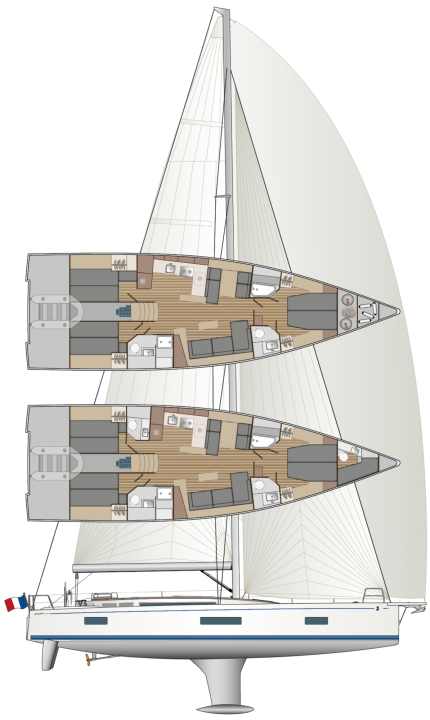
Technical data of the Beneteau First 53
- Designer: Argento/Biscontini
- CE design category: A
- Total length: 17,16 m
- Torso length: 15,98 m
- Waterline length: 15,40 m
- Width: 5,00 m
- Draught/alternative: 2,50/3,00 m
- Theoretical torso speed: 9.5 kn
- Weight: 15,5 t
- Ballast/proportion: 4,5 t/29 %
- Mast height above waterline: 25,80 m
- Mainsail: 87,0 m2
- Furling genoa (105 %): 78,9 m2
- machine (Yanmar): 59 kW/80 hp
- Fuel tank (2): 400 l
- Fresh water tank (3): 720 l
- Faeces tank (2): 160 l
Hull and deck construction
Infusion-laminated GRP sandwich construction with balsa wood core. GRP floor assembly bonded to the hull. Standard cast iron keel
Price and shipyard
- Base price ex shipyard: 810,400 € gross incl. 19% VAT.
- Standard equipment included: engine, sheets, railing, navigation lights, battery, compass, cushions, galley/cooker, bilge pump, toilet, electric coolbox, holding tank with suction
- Also included in the price: Fixed bowsprit, black painted aluminium mast, electric winch (1), Dyform rigging, radio remote control for electrics
- Guarantee/against osmosis: 2/2 years
As of 08/2024, how the prices shown are defined can be found here!
Shipyard
Chantier Beneteau, 85850 Saint Gilles Croix de Vie, France, www.beneteau.com
Distribution
Dealer network for Germany, Austria and Switzerland: www.beneteau.com
YACHT review of the Beneteau First 53
It has everything a fast cruising boat needs - and more. The Beneteau First 53 looks and sails racy in the performance configuration tested. A few limitations due to the design hardly spoil the strong overall impression. A boat with a wow effect!
Design and concept
- + Modern, characterful crack
- + High hull strength
- + Favourable base price
Sailing performance and trim
- + Easily retrievable power
- + Perfect steering feel
- - Little space for trimmers
Living and finishing quality
- + Innovative cabin layout and design
- + Good to very good comfort dimensions
- - Hardly any handrails to hold on to
Equipment and technology
- + Sensibly dimensioned fittings
- + Proper processing
- +/- Many, but sometimes expensive options
Almost always in front - Beneteau's First series
The First series has been sharpening Beneteau's profile for 45 years. Five important milestones in model development
First 30 - The ancestor
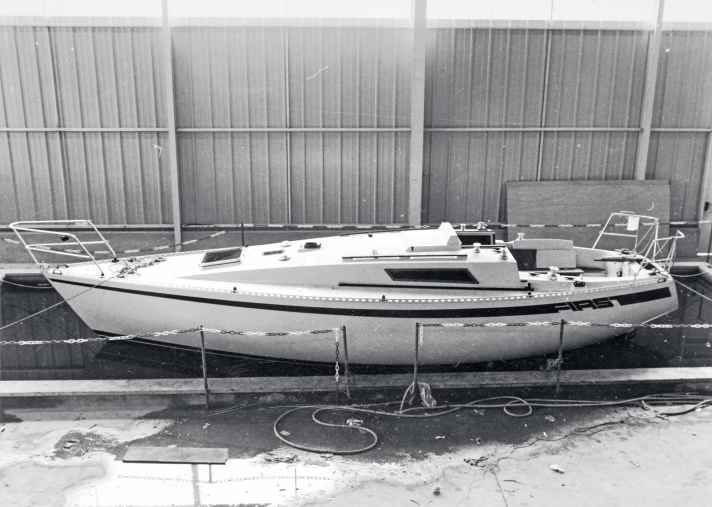
The era began in 1977. The 8.80 metre long cruiser/racer was based on the "Impensable" designed by André Mauric, which won the then renowned Half Ton Cup
First 18 - The People's First
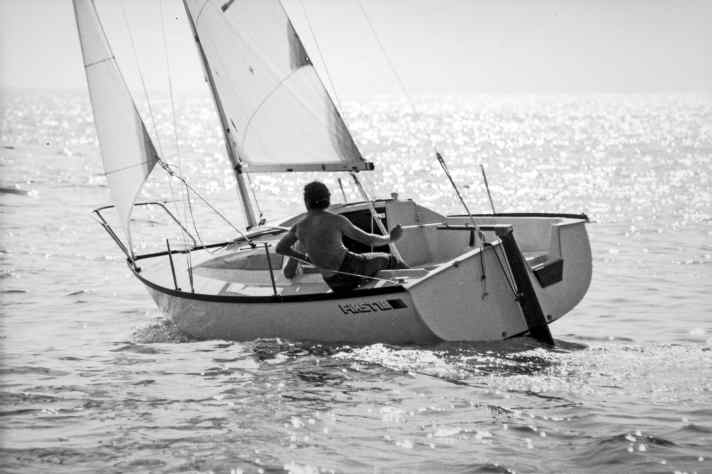
In 1979, Finot launched a small sports boat on the market: light, agile and affordable. Hundreds of them are sold - and last year, the former Seascape 18, now the First 18, also became its current successor
First 35 S5 - The test of courage
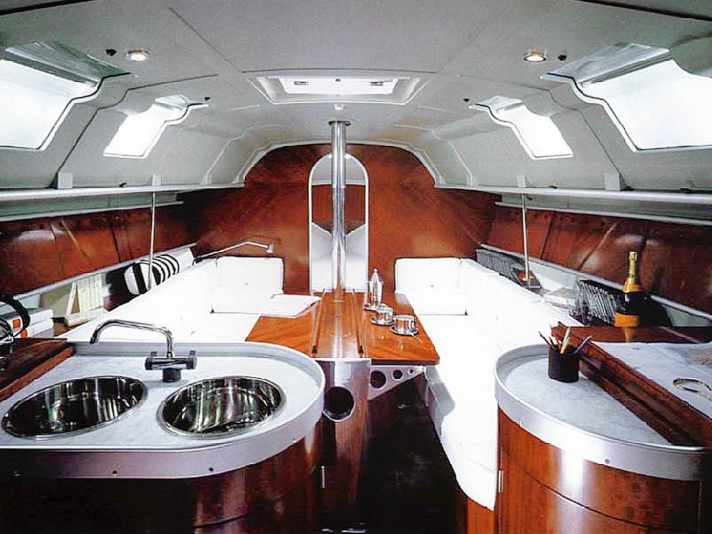
In 1988, Beneteau dared to experiment with the third generation of Firsts - and asked star designer Philippe Starck for help. Pininfarina also came on board later. Both revitalised the brand noticeably
First 40.7 - The legend
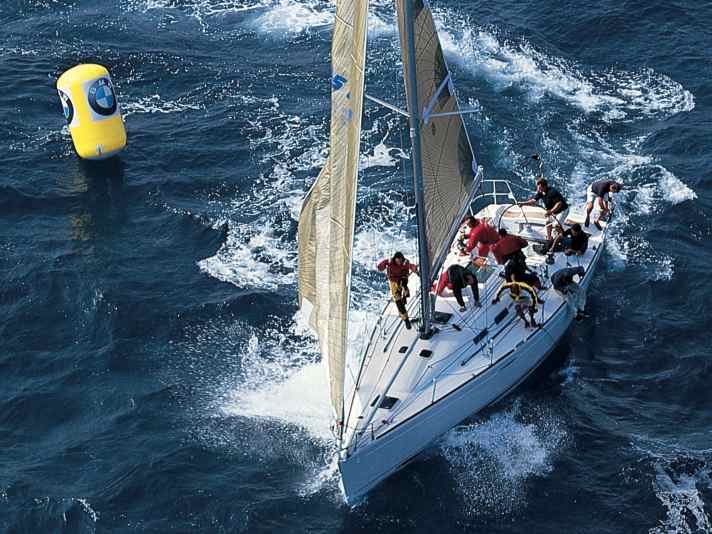
No model collects more silver than the twelve-metre yacht presented in 1997: from Fastnet to the Sydney Hobart Race. The ".7 series" is also the most commercially successful. It ranges from 21 to 47 feet
First 30 - The caesura
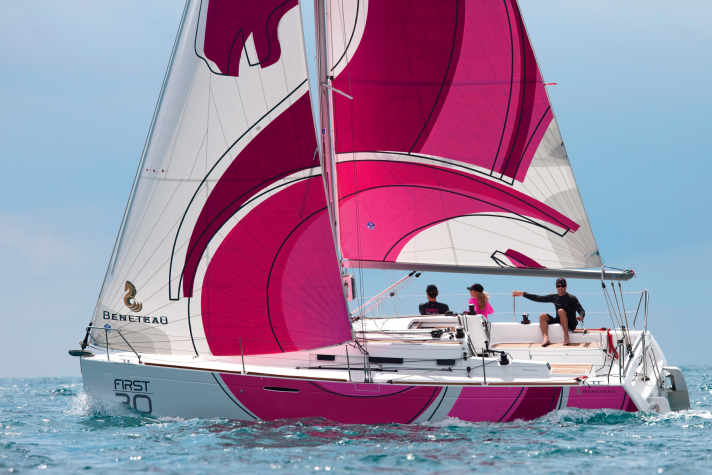
The sixth was almost the last generation. The radical-looking First 30 in particular caused a sensation in 2010, but was never quite able to fulfil the expectations of owners and shipyard. A painful flop
This article first appeared in YACHT 23/2019 and has been updated for this online version.

